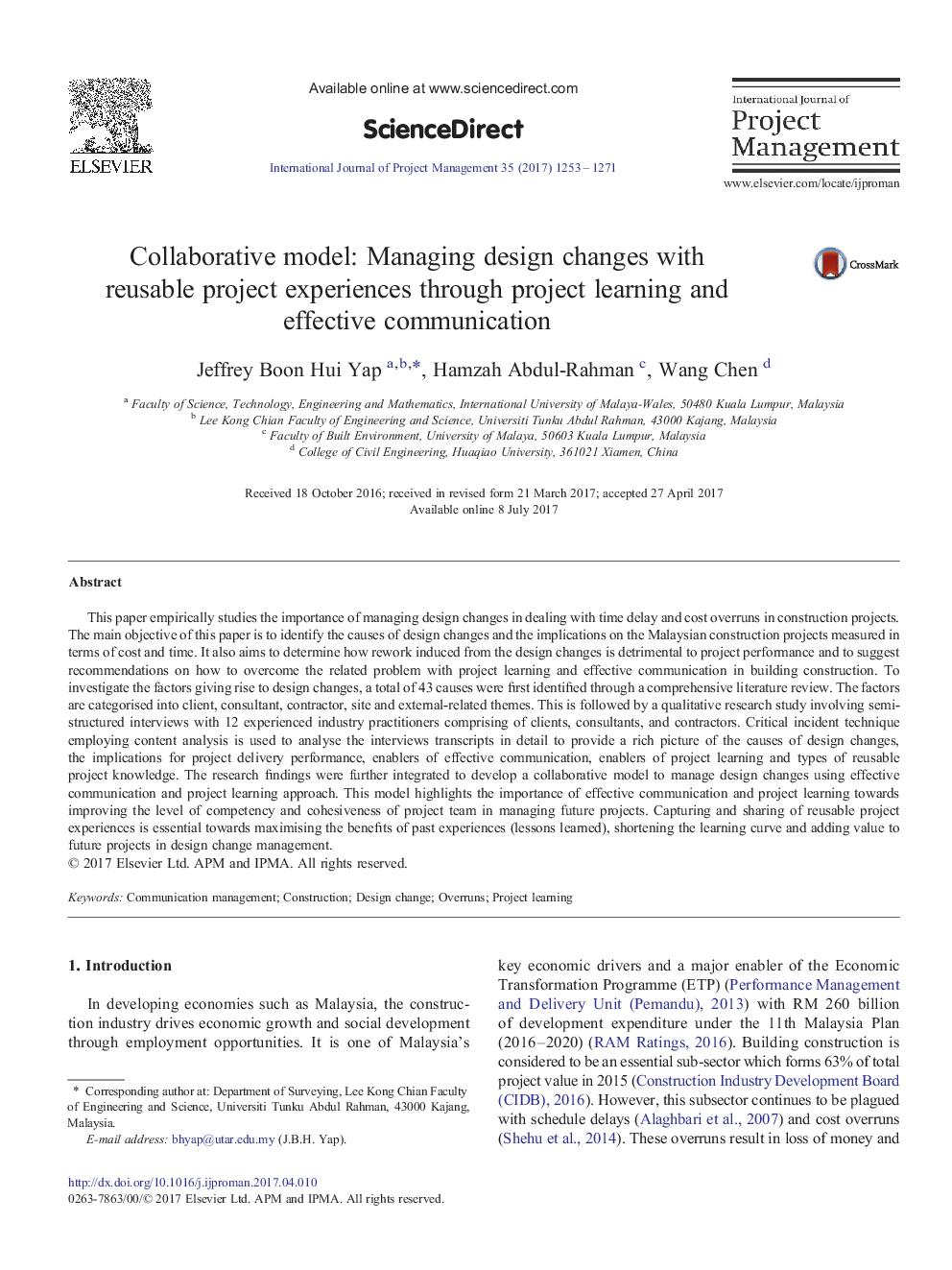| کد مقاله | کد نشریه | سال انتشار | مقاله انگلیسی | نسخه تمام متن |
|---|---|---|---|---|
| 4922105 | 1429653 | 2017 | 19 صفحه PDF | دانلود رایگان |
عنوان انگلیسی مقاله ISI
Collaborative model: Managing design changes with reusable project experiences through project learning and effective communication
ترجمه فارسی عنوان
مدل همکاری: مدیریت تغییرات طراحی با تجارب پروژه قابل استفاده مجدد از طریق یادگیری پروژه و ارتباط موثر
دانلود مقاله + سفارش ترجمه
دانلود مقاله ISI انگلیسی
رایگان برای ایرانیان
کلمات کلیدی
مدیریت ارتباطات، ساخت و ساز، تغییر طراحی، بیش از حد، یادگیری پروژه،
ترجمه چکیده
این مقاله تجربی اهمیت مدیریت تغییرات طراحی در برخورد با تاخیر زمانی و هزینه های بالای پروژه های ساختمانی را بررسی می کند. هدف اصلی این مقاله شناسایی علل تغییرات طراحی و پیامدهای پروژه های ساختمانی مالزی است که از لحاظ هزینه و زمان اندازه گیری می شود. همچنین هدف این است که تعیین کنید که چگونه تجدید ساختار ناشی از تغییرات طراحی زیان بر عملکرد پروژه است و توصیه هایی را برای چگونگی غلبه بر مشکل مرتبط با یادگیری پروژه و ارتباط موثر در ساخت و ساز ساختمان پیشنهاد می کند. برای بررسی عوامل ایجاد کننده تغییرات طراحی، در مجموع 43 علت در ابتدا توسط بررسی ادبی جامع شناسایی شد. این عوامل به مشتری، مشاور، پیمانکار، سایت و موضوعات مرتبط با آن دسته بندی می شوند. این یک مطالعه تحقیقی کیفی است که شامل مصاحبه نیمه ساختار یافته با 12 تمرینکننده صنعت با تجربه شامل مشتریان، مشاوران و پیمانکاران است. تکنیک حادثه بحرانی با استفاده از تجزیه و تحلیل محتوا برای تجزیه و تحلیل مصاحبه های رونوشت ها به طور دقیق برای ارائه یک تصویر غنی از علل تغییرات طراحی، پیامدهای عملکرد تحویل پروژه، ایجاد کننده ارتباطات موثر، عوامل آموزشی یادگیری پروژه و انواع دانش پروژه قابل استفاده مجدد استفاده می شود. یافته های تحقیق بیشتر به منظور ایجاد یک مدل همکاری برای مدیریت تغییرات طراحی با استفاده از روابط موثر و ارتباطی پروژه، یکپارچه شده است. این مدل اهمیت ارتباط موثر و یادگیری پروژه را به سمت بهبود سطح صلاحیت و انسجام تیم پروژه در مدیریت پروژه های آینده برجسته می کند. ضبط و به اشتراک گذاری تجربیات پروژه قابل استفاده مجدد برای به حداکثر رساندن مزایای تجارب گذشته (درس های آموخته شده)، کوتاه کردن منحنی یادگیری و اضافه کردن ارزش به پروژه های آینده در مدیریت تغییر طراحی ضروری است.
موضوعات مرتبط
مهندسی و علوم پایه
سایر رشته های مهندسی
مهندسی عمران و سازه
چکیده انگلیسی
This paper empirically studies the importance of managing design changes in dealing with time delay and cost overruns in construction projects. The main objective of this paper is to identify the causes of design changes and the implications on the Malaysian construction projects measured in terms of cost and time. It also aims to determine how rework induced from the design changes is detrimental to project performance and to suggest recommendations on how to overcome the related problem with project learning and effective communication in building construction. To investigate the factors giving rise to design changes, a total of 43 causes were first identified through a comprehensive literature review. The factors are categorised into client, consultant, contractor, site and external-related themes. This is followed by a qualitative research study involving semi-structured interviews with 12 experienced industry practitioners comprising of clients, consultants, and contractors. Critical incident technique employing content analysis is used to analyse the interviews transcripts in detail to provide a rich picture of the causes of design changes, the implications for project delivery performance, enablers of effective communication, enablers of project learning and types of reusable project knowledge. The research findings were further integrated to develop a collaborative model to manage design changes using effective communication and project learning approach. This model highlights the importance of effective communication and project learning towards improving the level of competency and cohesiveness of project team in managing future projects. Capturing and sharing of reusable project experiences is essential towards maximising the benefits of past experiences (lessons learned), shortening the learning curve and adding value to future projects in design change management.
ناشر
Database: Elsevier - ScienceDirect (ساینس دایرکت)
Journal: International Journal of Project Management - Volume 35, Issue 7, October 2017, Pages 1253-1271
Journal: International Journal of Project Management - Volume 35, Issue 7, October 2017, Pages 1253-1271
نویسندگان
Jeffrey Boon Hui Yap, Hamzah Abdul-Rahman, Wang Chen,
